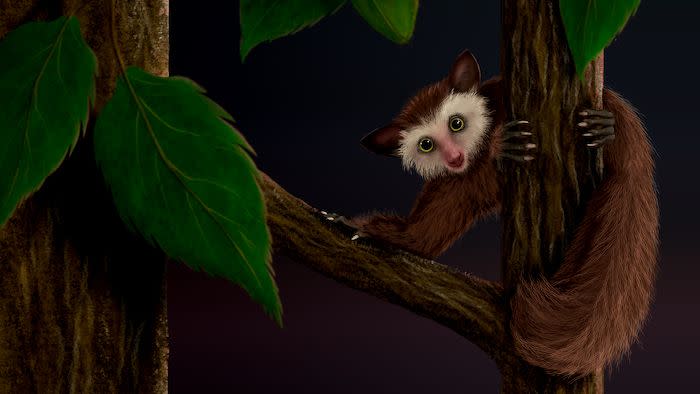New Clues Reveal the Origins of 'Little Cat Man,' America's Last Primate Before Humans

The lemur-like Ekgmowechashala thrived millions of years after North America’s last primates seemingly died out.
Using a phylogenetic reconstruction software and algorithm, scientists have discovered that North America’s last primate likely migrated from China via the Bering land bridge.
This discovery gives insight into the a paleontological idea known as the “Lazarus effect,” where species seem to reappear in the fossil record after a many-millions-of-years-long absence.
During the late Oligocene and early Miocene—some 30 million years before the primate Homo sapiens trekked across the Bering strait—North America was home to only one known primate: Ekgmowechashala. The fossilized remains of this lemur-like creature, which stood only a foot tall and weighed around five pounds, can be found throughout the Western U.S. from eastern Texas to Oregon. But for decades, its existence has been a complete mystery, because Ekgmowechashala (which means “little cat man” in Sioux) appears millions of years after primates died out on the continent.
In other words, Ekgmowechashala shouldn’t be there.
To unravel this mystery, scientists from the University of Kansas (KU) and the Institute of Vertebrate Paleontology and Paleoanthropology in Beijing analyzed fossil teeth and jaw fossils discovered in both North America and China. From that evidence, they were able to discern that Ekgmowechashala actually migrated to the western hemisphere via Beringia—the same path future humans would take millions of years later. The results of the study were published last week in the Journal of Human Evolution.
“Due to its unique morphology and its representation only by dental remains, its place on the mammalian evolutionary tree has been a subject of contention and debate,” Kathleen Rust, a doctoral candidate at KU’s Biodiversity Institute and Natural History Museum, said in a press statement. “It appears suddenly in the fossil record of the Great Plains more than 4 million years after the extinction of all other North American primates, which occurred around 34 million years ago.”
Although this seemingly anachronistic Ekgmowechashala fossil has been known to paleontologists for more than half a century, it wasn’t until the 1990s that KU scientists began piecing together the mystery. Back then, Chris Beard (Rust’s advisor on this new study) collected fossils from the Nadu Formation in the Baise Basin in Guangxi, China.
Because of a well-preserved Ekgmowechashala upper molar in the university’s archives, Beard was able to make a possible connection between this “little cat man” and an ancient Chinese sister taxon known as Palaeohodites, which means “ancient wanderer.” However, it was up to Rust to make the all-important phylogenetic connection.
“We collected a substantial amount of morphological data to create an evolutionary tree using a phylogenetic reconstruction software and algorithm,” Rust said in a press statement. “This evolutionary tree suggests a close evolutionary relationship between North American Ekgmowechashala and Palaeohodites from China.”
This means that Ekgmowechashala wasn’t an evolutionary product of North America—rather, it was an immigrant across the same land bridge that eventually brought humans to the continent. This highlights an idea in paleontology known as the “Lazarus effect,” where certain species seem to reappear in the fossil record after an extended period of “extinction.”
With Ekgmowechashala’s origins no longer a mystery, paleontologists now have a greater understanding of this second wave of primates in North America. But this small, lemur-like critter wasn’t the end of the story.
“Several million years later Ekgmowechashala shows up like a drifting gunslinger in a Western movie, only to be a flash in the pan as far as the long trajectory of evolution is concerned,” Beard said in a press statement. “After Ekgmowechashala is gone for more than 25 million years, Clovis people come to North America, marking the third chapter of primates on this continent.”
And that third chapter is still being written.
You Might Also Like


